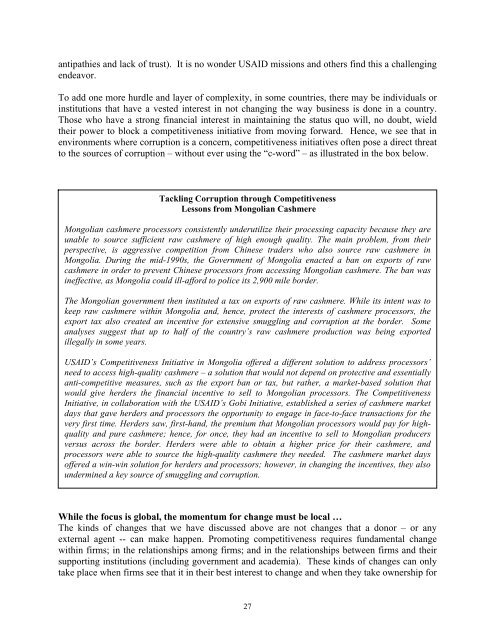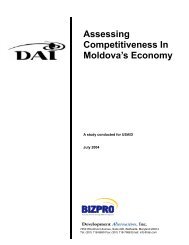Promoting Competitiveness in Practice - Economic Growth - usaid
Promoting Competitiveness in Practice - Economic Growth - usaid
Promoting Competitiveness in Practice - Economic Growth - usaid
You also want an ePaper? Increase the reach of your titles
YUMPU automatically turns print PDFs into web optimized ePapers that Google loves.
antipathies and lack of trust). It is no wonder USAID missions and others f<strong>in</strong>d this a challeng<strong>in</strong>g<br />
endeavor.<br />
To add one more hurdle and layer of complexity, <strong>in</strong> some countries, there may be <strong>in</strong>dividuals or<br />
<strong>in</strong>stitutions that have a vested <strong>in</strong>terest <strong>in</strong> not chang<strong>in</strong>g the way bus<strong>in</strong>ess is done <strong>in</strong> a country.<br />
Those who have a strong f<strong>in</strong>ancial <strong>in</strong>terest <strong>in</strong> ma<strong>in</strong>ta<strong>in</strong><strong>in</strong>g the status quo will, no doubt, wield<br />
their power to block a competitiveness <strong>in</strong>itiative from mov<strong>in</strong>g forward. Hence, we see that <strong>in</strong><br />
environments where corruption is a concern, competitiveness <strong>in</strong>itiatives often pose a direct threat<br />
to the sources of corruption – without ever us<strong>in</strong>g the “c-word” – as illustrated <strong>in</strong> the box below.<br />
Tackl<strong>in</strong>g Corruption through <strong>Competitiveness</strong><br />
Lessons from Mongolian Cashmere<br />
Mongolian cashmere processors consistently underutilize their process<strong>in</strong>g capacity because they are<br />
unable to source sufficient raw cashmere of high enough quality. The ma<strong>in</strong> problem, from their<br />
perspective, is aggressive competition from Ch<strong>in</strong>ese traders who also source raw cashmere <strong>in</strong><br />
Mongolia. Dur<strong>in</strong>g the mid-1990s, the Government of Mongolia enacted a ban on exports of raw<br />
cashmere <strong>in</strong> order to prevent Ch<strong>in</strong>ese processors from access<strong>in</strong>g Mongolian cashmere. The ban was<br />
<strong>in</strong>effective, as Mongolia could ill-afford to police its 2,900 mile border.<br />
The Mongolian government then <strong>in</strong>stituted a tax on exports of raw cashmere. While its <strong>in</strong>tent was to<br />
keep raw cashmere with<strong>in</strong> Mongolia and, hence, protect the <strong>in</strong>terests of cashmere processors, the<br />
export tax also created an <strong>in</strong>centive for extensive smuggl<strong>in</strong>g and corruption at the border. Some<br />
analyses suggest that up to half of the country’s raw cashmere production was be<strong>in</strong>g exported<br />
illegally <strong>in</strong> some years.<br />
USAID’s <strong>Competitiveness</strong> Initiative <strong>in</strong> Mongolia offered a different solution to address processors’<br />
need to access high-quality cashmere – a solution that would not depend on protective and essentially<br />
anti-competitive measures, such as the export ban or tax, but rather, a market-based solution that<br />
would give herders the f<strong>in</strong>ancial <strong>in</strong>centive to sell to Mongolian processors. The <strong>Competitiveness</strong><br />
Initiative, <strong>in</strong> collaboration with the USAID’s Gobi Initiative, established a series of cashmere market<br />
days that gave herders and processors the opportunity to engage <strong>in</strong> face-to-face transactions for the<br />
very first time. Herders saw, first-hand, the premium that Mongolian processors would pay for highquality<br />
and pure cashmere; hence, for once, they had an <strong>in</strong>centive to sell to Mongolian producers<br />
versus across the border. Herders were able to obta<strong>in</strong> a higher price for their cashmere, and<br />
processors were able to source the high-quality cashmere they needed. The cashmere market days<br />
offered a w<strong>in</strong>-w<strong>in</strong> solution for herders and processors; however, <strong>in</strong> chang<strong>in</strong>g the <strong>in</strong>centives, they also<br />
underm<strong>in</strong>ed a key source of smuggl<strong>in</strong>g and corruption.<br />
While the focus is global, the momentum for change must be local …<br />
The k<strong>in</strong>ds of changes that we have discussed above are not changes that a donor – or any<br />
external agent -- can make happen. <strong>Promot<strong>in</strong>g</strong> competitiveness requires fundamental change<br />
with<strong>in</strong> firms; <strong>in</strong> the relationships among firms; and <strong>in</strong> the relationships between firms and their<br />
support<strong>in</strong>g <strong>in</strong>stitutions (<strong>in</strong>clud<strong>in</strong>g government and academia). These k<strong>in</strong>ds of changes can only<br />
take place when firms see that it <strong>in</strong> their best <strong>in</strong>terest to change and when they take ownership for<br />
27
















